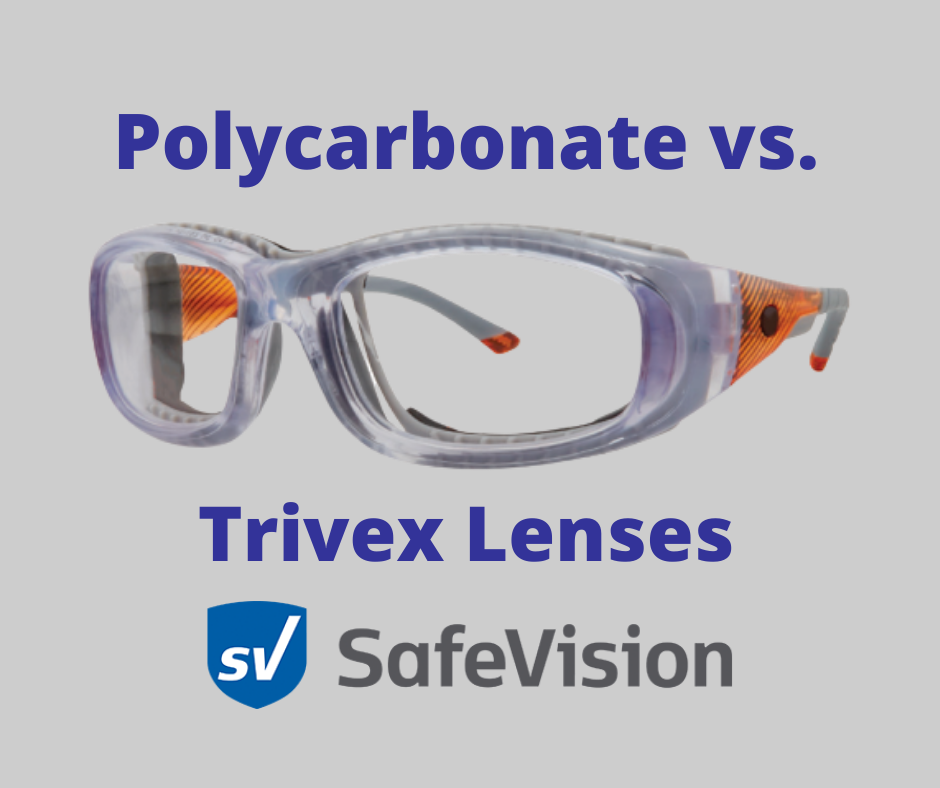When selecting eyewear, choosing a polycarbonate or Trivex lens is highly recommended for your sunglasses, sports eyewear, and everyday eyewear. These lenses are more impact-resistant and also noticeably lighter and thinner than regular plastic lenses. Plus, they block 100% of ultraviolet (UV) rays from the sun.
This combination of qualities makes polycarbonate and Trivex lenses a top choice for safety eyewear as well. In this blog, we discuss Polycarbonate vs. Trivex lenses to help you choose which lens is best for your safety eyewear.
Polycarbonate lenses
This material was developed during the “space race” of the late 1960s. It was used for helmets and visors for astronauts. It was soon adapted for use in safety eyewear applications due to its superior impact resistance. By 1978 the first single vision ophthalmic lenses were being produced. The following years brought improvements to resin purity, manufacturing, and lab processing.
Tiny pellets of this thermoplastic material are melted down and injected into a high-pressure mold to produce polycarbonate lenses. An unfortunate byproduct of this production method is the lack of uniformity of the material throughout the lens due to the injection points.
Today, polycarbonate is the most common material for safety eyewear in the USA. These lenses are less likely to break when compared to regular plastic lenses and are considered impact resistant per ANSI Z87.1 standards.
Trivex lenses
Trivex is a newer lens material developed in 2001. It was originally developed for the military, as visual armor. PPG Industries adapted the technology for the optical industry. The material was given the name “Trivex” because of its three main properties which are good optics, lightweight, and strength.
Per ANSI Z87.1 this is another impact-resistant and lightweight lens material used for safety eyewear. However, these lenses are produced with a urethane-based monomer in a cast molding process. As the liquid is baked it sets to form the lens more uniformly than the injection molding process used to create polycarbonate lenses.
Why do we recommend Trivex?
Abbe value is the measurement of the dispersive properties of a material. The lower the number the more a material will disperse light into its component colors. This causes chromatic aberration which may be seen as color fringes or blur toward the edges of the lens. With an Abbe Value of 30, polycarbonate is more likely to cause these color fringes and blur in the periphery of the lens when compared to Trivex who’s Abbe Value is 43.
Specific gravity or density of a material is its weight expressed in grams per cubic centimeter. The specific gravity of polycarbonate is 1.20 and Trivex is 1.11. Trivex is a lighter-weight material in this regard and the lightest lens material available today.
Chemical resistance: Polycarbonate is a susceptible variety of chemicals in both liquid or vapor states which weakens the material and can crack lenses when exposed. Even though polycarbonate lenses almost always come with a coating doesn’t mean this concern is eliminated. When a lens is cut out to be placed in a pair of eyeglass frames it can strip the coating off the edge. That means chemicals like ammonia, which is common in both household cleaning products and industrial environments, can seep into the rim of the eyewear and attack the raw edges of the material.
The cracking and/or fogging typically emanating from the edge of the polycarbonate lens can occur rapidly. Cracked lenses are a hazard because they do not have their original impact strength. They are, therefore, no longer compliant with the CSA or ANSI standard and should be replaced immediately.
A representative at SafeVision can discuss the pros and cons of each lens to help you decide if the Trivex or polycarbonate is better for your needs.
Finding the Proper Frames For Your Lenses
When choosing your lenses, you also have to consider what frames they’ll be inserted in. To keep your eyes safe, you should invest in high-quality safety frames explicitly designed for your sport or industry. Regular frames are not strong enough to protect your eyes from projectiles hitting you and could result in damage to the frames and lenses and damage to your eyes. Talk to your SafeVision corporate program representative to learn more about which frames are best for you.
Shop online at SafeVision.com and find both polycarbonate and Trivex (or Phoenix) lenses for your industry or sport.

